The Intel Haswell-E CPU Review: Core i7-5960X, i7-5930K and i7-5820K Tested
by Ian Cutress on August 29, 2014 12:00 PM ESTIntel Haswell-E Overclocking
One of the burgeoning questions relating to overclocking over the past couple of years has been the quality of Intel’s construction under the heatspreader relating to thermal interface material and adhesives. This caused enough of a talking point for Intel to release Devil’s Canyon (read our review here) which featured an upgraded interface and essentially reduced the thermal pressure restricting the overclock.
Thankfully Intel has not decided to play around with the extreme edition platform too much since Nehalem. Although recent reports suggest that Intel is using an epoxy to bind the die to the heatspreader, one tell-tale sign that a goopy TIM is not being used is the hole in the heatspreader in one of the corners.
Looking through the previous generations, Sandy-E, Ivy-E and Haswell-E shows this hole, which is typically thought to allow for expansion of the heatspreader and/or gas trapped inside due to the heat. Also due to the way that the epoxy is handled, the heatspreader cannot be removed without force and destroying parts the silicon die.
Due to the way that the CPU is arranged, with the cores to the left and right of center, there may develop a series of recommendations when using different methods of applying thermal paste as the sources of the heat will most likely be in these two regions. I would advise the normal procedure of applying thermal paste here: a small blob in the middle and allow the heatsink to spread the TIM through applied pressure. This helps remove air bubbles as the TIM spreads; spreading it out manually leads to air bubbles all over the place and is not recommended for high thermal sources.
In our results below we are using a Cooler Master Nepton 140XL closed loop liquid CPU cooler, and following the instructions above our CPU temperatures stay extremely low until we pile on the overclock. In fact I was seeing less than 30ºC while idle, which should bode well for overclocking.
Methodology
Our standard overclocking methodology is as follows. We select the overclock options and test for stability with PovRay and OCCT to simulate high-end workloads. These stability tests aim to catch any immediate causes for memory or CPU errors.
For manual overclocks, based on the information gathered from stock testing, we start at a nominal voltage and CPU multiplier, and the multiplier is increased until the stability tests are failed. The CPU voltage is increased gradually until the stability tests are passed, and the process repeated until the motherboard reduces the multiplier automatically (due to safety protocol) or the CPU temperature reaches a stupidly high level (100ºC+). Our test bed is not in a case, which should push overclocks higher with fresher (cooler) air.
Results
Due to the timing of our testing, we were only able to test two i7-5960X CPUs. Both of these were M0 stepping samples, the same as the retail stepping as far as we understand. The i7-5960X for reference is a 3.0 GHz base clock CPU with 8 cores, with a stock load voltage around 1.050 volts. Standard turbo modes allow 3.5 GHz, and so we start our testing at 3.5 GHz on all cores at 1.000 volts set in the BIOS. Where load line calibration was possible, it was enabled to match our setting as closely as possible, but otherwise only the CPU voltage was adjusted.
The first sample has a lot of early headroom with +0.100 volts allowing for an extra +1.1 GHz, or a 36.7% overclock. It has been a long while since numbers like +36.7% has been bandied around Intel’s extreme range, with only the i7-920 type Nehalem CPUs doing that sort of overclock in its stride.
The sweet spot for this CPU seems to be at around 4.4 GHz where the CPU voltage is just starting to rise but peak temperatures are under 75ºC.
Unfortunately our second sample was pretty much a dud by comparison. The voltage needed early on in the overclock went up quickly. This time we were unable to monitor temperatures due to a BIOS issue, but had a power meter on hand. We still managed a +1.1 GHz overclock easily enough, although +0.175 volts was required.
At 4.1 GHz, peak power is +104W over the system power draw at stock, with another 40W at 4.3 GHz. This shows that Haswell-E can be a power hog from even small overclocks, and thus users must have cooling to match. If we add the 140W TDP and the +140W more from the overclock (it would most likely be more than this due to the change of efficiency in the PSU curve), then a mildly overclocked CPU is fast approaching 300W. One can imagine that a highly clocked 4.7 GHz sample would be nearer 400W, and thus users should purchase power supplies to match.
A Problem with Haswell
One issue from Haswell does crop up with Haswell-E: the variability in the quality of the processors. Intel only guarantees that the processor will run at the specific frequency and voltage that is applied out of the factory: any other speed is out of specification and not supported. With Haswell LGA1150 CPUs, while the turbo frequency of the i7-4770K was 3.9 GHz, some CPUs barely managed 4.2 GHz for a 24/7 system.
If we consider that the i7-4770K only needs one of those CPU cores to be below quality to ruin overclockability, then placing double the cores on the i7-5960X is asking for double the trouble. Time to put some numbers to this:
In ASUS’ press deck for overclocking recommendations that came with the X99-Deluxe, they tell us the following:
i7-5960X at 4.4 GHz with 1.300 volts is below average
i7-5960X at 4.5 GHz with 1.300 volts is average
i7-5960X at 4.6 GHz with 1.300 volts is above average
By that standard our first CPU is around average and the second CPU we tested is below average. Even with these guidelines, it would seem that other reviewers and even manufacturers are getting a wide array of results. I have heard of reports of CPUs getting 4.7 GHz on a water loop, whereas others are testing a range of CPUs and not getting more than 4.4 GHz, like our second sample.
ASUS is recommending that anything over 1.25 volts requires a water/liquid cooling as a bare minimum, with up to 1.35V needing a triple (3x120mm) radiator setup depending on ambient temperatures. As with most overclocked setups, this means that the enthusiast user must decide between clock speed or fan noise for their machine.
Another issue with Haswell-E is the current draw of the CPU. ASUS is stating that the standard current draw for the CPU can reach 25 amps, meaning that the power supply must be capable of supplying at least 30 amps on the EPS12V cable. This is covered for most home-build non-OEM power supplies with an 80 PLUS rating, but suggests that a cheap power supply might trigger the over-current protection early.
Comparison to Ivy Bridge-E, Sandy Bridge-E, Haswell
As part of our testing, we hooked up our older i7-4960X and i7-3960X to the ASUS Rampage IV Black Edition, as well as compared to our previous i7-4790K Haswell overclocks:
Our i7-3960X sample at the time was actually a really nice overclocking CPU, in comparison to our i7-4960X which was below overage. I put two values here for the i7-5960X, showing that a 4.3 GHz overclock, while it is lower in number than the 4.8 GHz of the i7-3960X, is actually around the same percentage overclock. If we have a good i7-5960X for comparison, then +50% overclock comes very easily.
The next question then is which one is better for performance? While the Haswell-E CPUs have a lower frequency than the previous generations, they do have the benefit of a higher IPC and DDR4 memory. There is also the core count, with the i7-5960X having 8 cores at 4.3/4.6 GHz against the six cores or four cores.
It should be obvious that for single core throughput, the i7-4790K wins at 4.7 GHz:
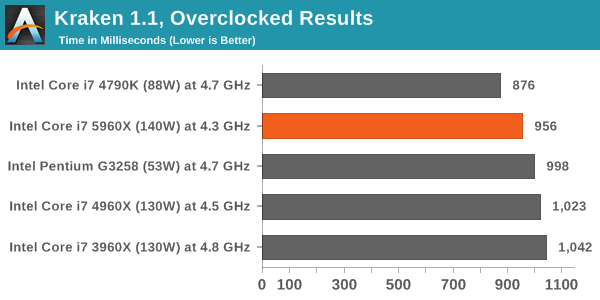
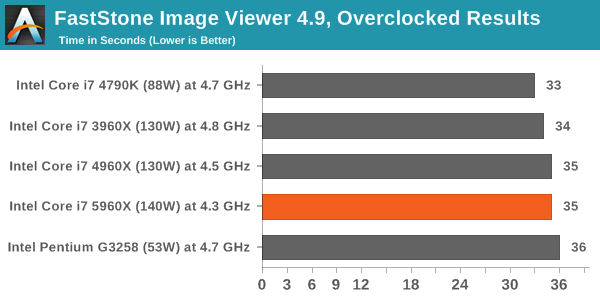
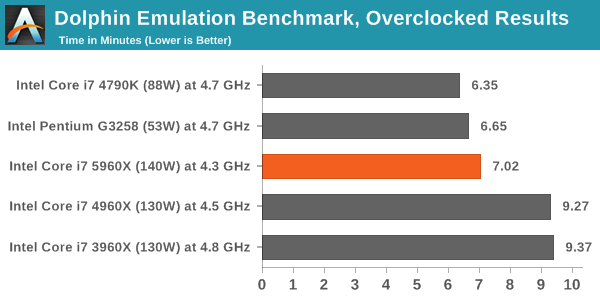
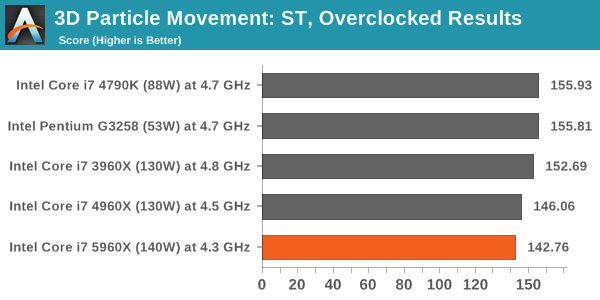
In most benchmarks, the 5960X, 4960X and 3960X are actually evenly matched for single threaded performance, with the 5960X taking the edge on software that can take advantage of the newer instruction sets.
For multithreaded tasks, an overclocked i7-5960X is the only way to go:
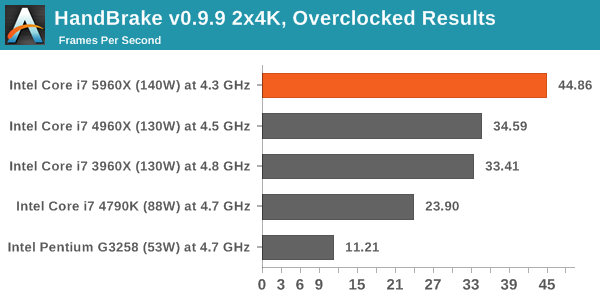
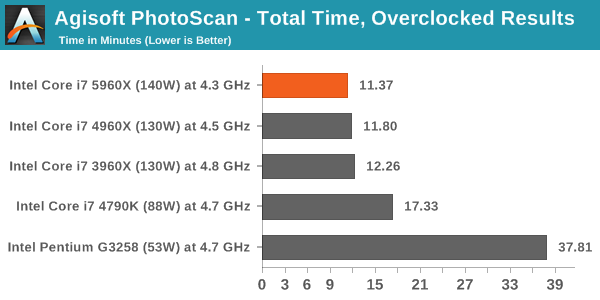
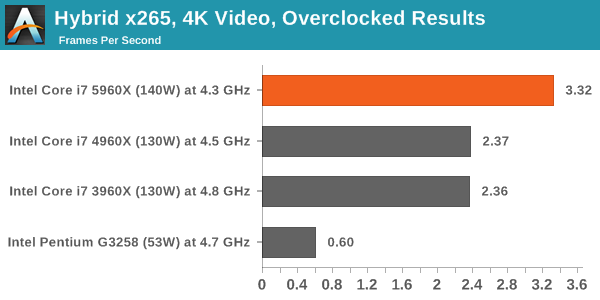
The graphs later in the review comparing each of these processors at stock will have our overclocked results as well.




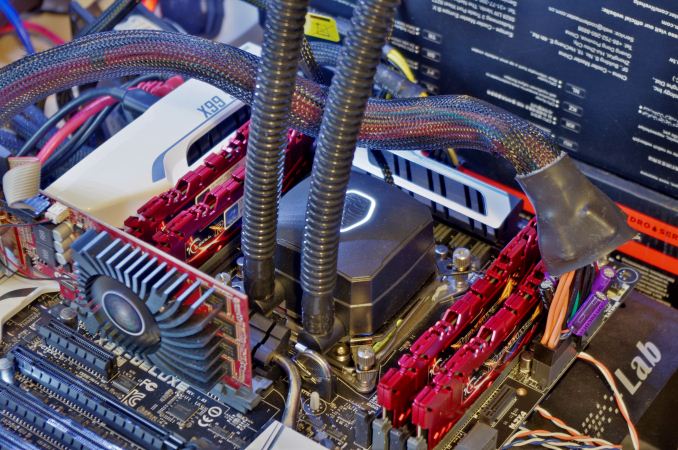
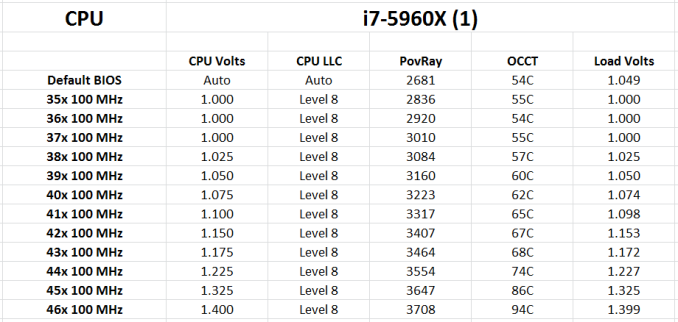
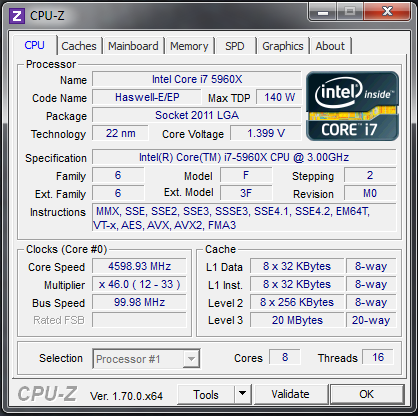
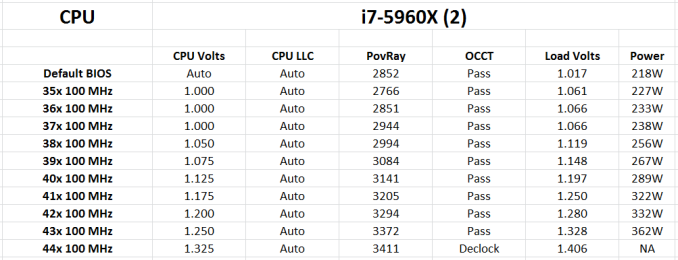










203 Comments
View All Comments
NeatOman - Friday, August 29, 2014 - link
Sooo... its good for very high end gaming and rendering.Motion2082 - Friday, August 29, 2014 - link
Hey guys, I'm running a i7 2600k on ME4Z @ 4.8GHz. My system is fast enough for most applications, only struggles with multiple applications running. Should I be looking at Haswell-E or waiting until Broadwell? Only annoyance I have with i7 2600k is slow video encoding and restrictions on multi-tasking.TeXWiller - Saturday, August 30, 2014 - link
Adjust manually your process priorities and core affinities, if necessary. The old work horse will take you a lot longer still. I may have a 14-hour rendering process going with fully loaded cores and still run a nice FPS session at will, provided that I adjust the process priority manually.mapesdhs - Saturday, August 30, 2014 - link
What is your RAM speed? I find 2133 @ CL10 to be optimal with the M4E/Z (I have
five of those boards, all with 2700Ks @ 5.0).
Make sure you have a good SATA3 SSD to exploit the Intel SATA3 port. Don't use
the Marvell ports. An H80i with NDS fans works really well for low-noise, but even an
old TRUE with any two decent fans will happily run a 2700K @ 5.0 (I've used the
TRUE, TRUE Black, VenomousX, Phanteks, etc., but recently bought a whole pile of
refurb H80s for a good price).
If you want an intermediate upgrade, get a used 3930K C2, a good used X79 board
(I keep buying the ASUS P7X79 WS, done five so far), move over your RAM, etc.
Note the same caveats re Intel/Marvell ports, use an H100i + NDS fans instead, and
voila, you're up & running away with a 6-core for not much outlay. A recent build I did
empllyed a 3960X which cost 245 UKP, the above ASUS board for 190 UKP, etc.
Gave 1221 for CB R15, while your 2600K @ 4.8 should give around 850, so that's a
very nice bump for threaded tasks and running multiple apps in general.
I suggest an 840 Pro or 850 Pro for an SSD, though there are lots of used bargains
available. I bagged a 512GB Vector for 160, ideal as a cache for AE, while an OEM
840 Pro was only 87. Best of all, I keep getting 1475W Thermaltake Toughpower XT
Gold units for around 125 UKP (less than half normal new cost), perfect for handling
four heavy GPUs for CUDA or whatever (my system has four GTX 580 3GB atm) in
an oc'd 6-core system with multiple SSDs, RAID, etc.
More references, examples & suchlike available on request - don't want to clog this thread.
Ian.
LordHaHa - Friday, August 29, 2014 - link
Mixed feelings on this one. This is a solid effort here, and the 5820K at around $390 is potentially interesting, seems very similar to the 3930K and it's a bit cheaper by default.That said, I don't see much of a reason to upgrade from SB-E or IB-E if you already have something in that. Certainly even the 5820K is a bit overkill for gaming for the price.
I do have to say we live in strange times where even latter-day Core 2 systems (paired with very good video cards, as a caveat) are still fairly capable for most single player gaming environments; certainly they can still handle any casual task thrown at them. And anyone who's got to Sandy Bridge has had little reason to upgrade their systems yet, for sure. Ten years ago, saying "I have no reason to upgrade my 2-4 or so generation old box" would have been crazy talk.
Laststop311 - Friday, August 29, 2014 - link
Very impressed with the 8 core overclock. I was worried that having such a low stock meant the oc wouldn't be too good. They had it on a crappy closed loop 140mm rad and it did well. I have a custom loop that cools the motherboard chipset and vrm, the cpu, and the gpu. A triple 5.25" reservoir with dual mcp 655 pumps in series at setting 4 1 below max pump speed a 60mm thick 420mm rad with 6x 140mm noctua a15 fans in push pull. Hopefully I can hit 4.8ghz i'll be very happy but as long as i can hit 4.5ghz ill be satisfied. I'm coming from a 4261mhz i7-980x so this is going to be a rly big upgrade for my video work and even a noticeable boost in gaming not huge but noticeable.I'm totally pleased with the i7-5960x. Waited 3 generations from nehalem to upgrade. With haswell-e ill be waiting at least 4 possibly 6 generations to upgrade unless some crazy new chipset geature makes me do it earlier.
cactusdog - Saturday, August 30, 2014 - link
I really wish they took the voltage regulator off the CPU. Its really a bit sad that a 4790K can beat this highend expensive chip in single threaded tasks. I was really looking forward to this but performance doesn't justify the cost unless you do a lot of multi threaded stuff. With skylake coming with PCI-E 4 this system is going to be outdated pretty quickly. One thing is for sure, the days of big overclocks on the CPU side are over.ToTTenTranz - Saturday, August 30, 2014 - link
The 28 lanes in the 5820k don't make much difference in SLI because it uses the SLI bridge as interconnect between the graphics cards.It would be interesting to see if the 16x/8x configuration makes any difference with two of the newer bridgeless Radeon cards.
Especially since the first build exemplified in this review uses that same configuration (5820k with two Radeon 285 cards).
mlambert890 - Monday, September 1, 2014 - link
there absolutely is *not* data going across the sli bridge at all. the only thing going across the bridge is timing and signaling info. it is a tiny 1GB/s interconnectat extremely high resolutions on pcie 2 SLI is where you specifically DO need more lanes. pcie 3 alleviates this. multi 4k would bottleneck again, but the best gpus can barely handle a single 4k in high detail anyhow even in tri-sli
fallaha56 - Saturday, August 30, 2014 - link
Hmm one last benchmark (emulation-related) I'd like to see (and suspect many others would too) -run PCSX2 in software mode with 8+ threads and see if there's benefits.Try something really tough like Shadow of the Colossus.
Looks like this chip is a man looking for a mission, is that it?